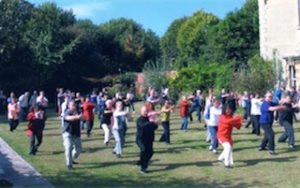Tai chi 37 Form (Taiji 37 Form) is based on the principles of Nanpai Taijiquan (Southern school). It consists of 37 positions flowing seamlessly from one into the next. Practising the form is a popular way to begin studying Tai Chi. It’s movements are noted for their mindful calming qualities. It will provide you with a clear exercise routine, a focus and structure for practise. It can also be a basis from which to begin to explore Tai chi in more detail through the greater understanding of Tai chi postures and forces. Through this, you will begin to unlock the wider health benefits of the practise.
Tai Chi History
Tai Chi Chuan (Taijiquan) was first practised as a martial art and used for fighting in the 13th Century, with the slogan ‘soft overcomes strong’. Taiji means ‘without limits’ and quan means boxing, fist, or method of working (i.e. discipline). Over the centuries, these ‘Taijiquan’ techniques were developed and taught in secret within families and used for fighting. It was not until the 1920’s that Yang Chengfu began to teach Tai Chi for its health benefits.
Many people in the west are familiar with a number of Tai Chi Styles such as Yang, Wu and Chen. These styles all form part of the northern school (Beipai). Taiji 37 is the name for the Tai Chi practise developed by the Southern School (Nanpai). Many of the Nanpai masters were killed by bombing during the second world war whilst en-route to Shanghai, and so this practise is less well known.
What is Tai Chi 37 Form?
People often think of Tai Chi as a series of movements, or form. Traditionally however, Tai Chi was taught as standing postures. The aim was to activate the dantian (the body’s energy centre) and allow the body’s energy to flow more freely. In this way fighters developed Taijijin (Tai Chi forces) which were used in combat. Today in Taiji 37 we develop the same Tai Chi forces in order to clear the body of sick information (binqi) through the body’s energy channels and meridians.
Learning a Tai Chi form is a useful basis for practise, but it is not the goal in itself. The poetry of the Nanpai school speaks about being invisible and without form. This means that, the Tai Chi form is really a series of standing postures and stances that flow from one into another through spontaneous movement. Practising the form slowly is not just about calming the mind and making soft flowing shapes, it allows us to explore and understand each of these postures both physically and energetically.
Tai Chi Philosophy and Principles
The philosophy and practise of Tai Chi is rooted in ancient Chinese traditions of Daoism and Buddhism and the philosophy of Yin and Yang. This is not just about relaxing, but about stretching and opening the body at the same time. It means developing both soft and strong force with mind and body working in harmony. It is also about sinking down and lifting up, being full and empty, light and heavy, and harmonising the internal and external. Based on these ideas, Yang Chengfu developed 10 principles for Tai Chi practise. These can be found here.
Tai Chi 37 Form Classes
In Taiji 37 beginners classes, we practise both standing and moving Tai Chi exercises as well as learning the Taiji37 form. Daoyin, spontaneous movement and breathing exercises from the Taijiwuxigong system (Tai chi & Qi Gong) are also used in order to stretch and open, cleanse and regulate the body.
For a more detailed exploration of Tai Chi philosophy and history take a look at the Heaven Mountain website.
